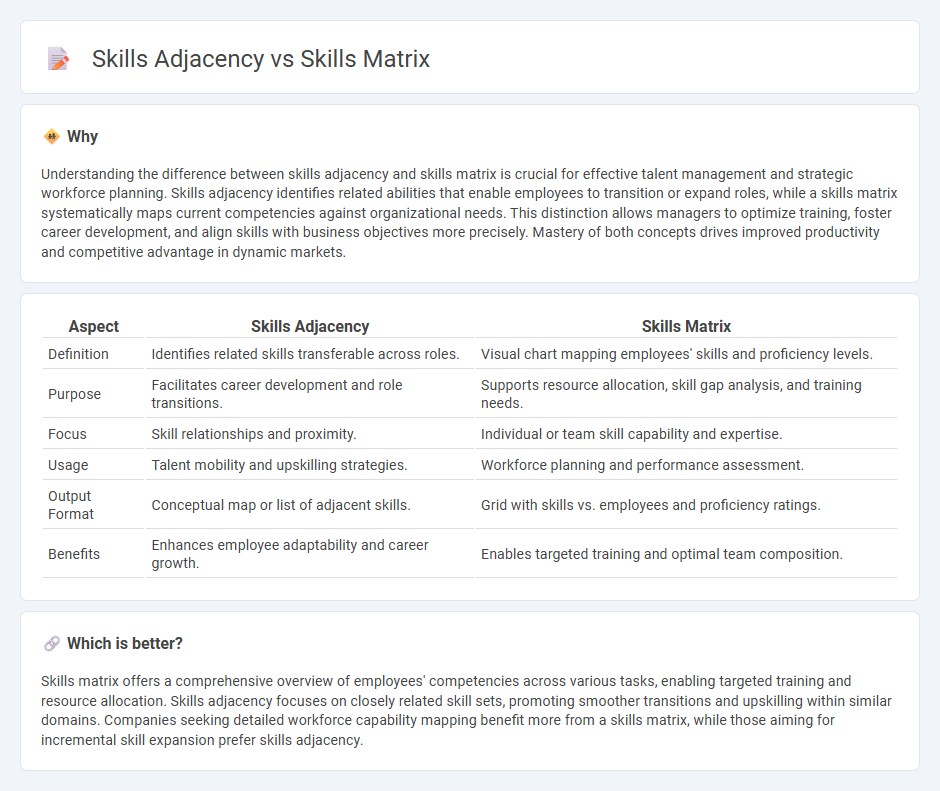
Skills adjacency identifies related competencies that enhance workforce flexibility and innovation by focusing on overlapping expertise areas. Skills matrix provides a comprehensive grid that maps employee skills against job requirements, facilitating targeted development and efficient resource allocation. Explore more to understand their distinct roles in optimizing talent management.
Why it is important
Understanding the difference between skills adjacency and skills matrix is crucial for effective talent management and strategic workforce planning. Skills adjacency identifies related abilities that enable employees to transition or expand roles, while a skills matrix systematically maps current competencies against organizational needs. This distinction allows managers to optimize training, foster career development, and align skills with business objectives more precisely. Mastery of both concepts drives improved productivity and competitive advantage in dynamic markets.
Comparison Table
| Aspect | Skills Adjacency | Skills Matrix |
|---|---|---|
| Definition | Identifies related skills transferable across roles. | Visual chart mapping employees' skills and proficiency levels. |
| Purpose | Facilitates career development and role transitions. | Supports resource allocation, skill gap analysis, and training needs. |
| Focus | Skill relationships and proximity. | Individual or team skill capability and expertise. |
| Usage | Talent mobility and upskilling strategies. | Workforce planning and performance assessment. |
| Output Format | Conceptual map or list of adjacent skills. | Grid with skills vs. employees and proficiency ratings. |
| Benefits | Enhances employee adaptability and career growth. | Enables targeted training and optimal team composition. |
Which is better?
Skills matrix offers a comprehensive overview of employees' competencies across various tasks, enabling targeted training and resource allocation. Skills adjacency focuses on closely related skill sets, promoting smoother transitions and upskilling within similar domains. Companies seeking detailed workforce capability mapping benefit more from a skills matrix, while those aiming for incremental skill expansion prefer skills adjacency.
Connection
Skills adjacency identifies related competencies that enhance cross-functional expertise, while a skills matrix visually maps these competencies across team members, highlighting gaps and overlaps. Together, they enable managers to optimize resource allocation and tailor development plans by understanding how adjacent skills complement each other within the workforce. This integration supports strategic workforce planning and improves overall organizational performance.
Key Terms
Competency Mapping
Skills matrix organizes employee competencies by listing specific skills against team members, enabling clear identification of skill gaps for targeted upskilling. Skills adjacency maps related competencies, highlighting transferable skills and potential cross-training opportunities within similar domains. Explore how integrating both frameworks can enhance your competency mapping strategy for workforce development.
Skill Gaps
A skills matrix provides a structured overview of existing competencies within a team, highlighting proficiency levels to identify explicit skill gaps. Skills adjacency emphasizes related or transferable skills that employees can leverage to bridge gaps, promoting agile workforce development. Explore how combining these methods can optimize your talent strategy and close critical skill gaps effectively.
Cross-functional Skills
A skills matrix visually maps individual competencies across various roles, highlighting cross-functional skills essential for collaboration and versatility in project teams, while skills adjacency emphasizes the proximity and transferability of related skills, fostering agile workforce development. Cross-functional skills such as communication, problem-solving, and adaptability are critical in both approaches to enhance team efficiency and innovation. Discover more about leveraging these tools to optimize talent management and drive organizational success.
Source and External Links
How to Create a Skills Matrix for Success [Free Template] - AIHR - A skills matrix, also known as a competency matrix, is a tool to map necessary and available skills, helping identify gaps and improving team performance through steps like defining relevant skills and assessing current skill levels on a rated scale.
What Is a Skills Matrix? Benefits, Examples, Template - Whatfix - A skills matrix visually records employee skills and competencies, arranged in a table to facilitate strategic hiring, upskilling, and project assignments by mapping roles and skill proficiency scores.
Skills Matrix How-To Guide: Template, Examples & Tips - Personio - A skills matrix is a visual framework mapping employee skills and proficiency levels that supports better decision-making, resource allocation, and spotting skill gaps to help organizations manage and plan talent strategically.
 dowidth.com
dowidth.com